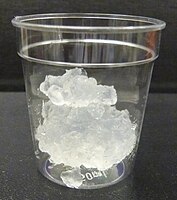
Photo from wikipedia
Abstract Adsorption performance and stability of the carboxyl groups modified straws and their extracts of cellulose, lignin, and hemicellulose for Pb2+ were investigated, and the optimum pH range for Pb2+… Click to show full abstract
Abstract Adsorption performance and stability of the carboxyl groups modified straws and their extracts of cellulose, lignin, and hemicellulose for Pb2+ were investigated, and the optimum pH range for Pb2+ adsorption was determined by considering both the stability and capacity of the modified biosorbents for the first time. Results showed that adsorption capacity and stability of the straws and extracts were both improved significantly after modification. Adsorption capacities of the modified straws and extracts followed the order: modified hemicellulose >modified lignin, modified straw > modified cellulose, while stability of them followed the reverse order. In the optimum pH range from 4.0 to 5.0, modified rape and cotton straw showed better stability than the modified maize straw, and total organic carbon (TOC) values determined from the two modified straws and extracts were lower than 5.0 mg L-1 even after adsorption for 30 days, which reached the drinking water standard in China.
Journal Title: Arabian Journal of Chemistry
Year Published: 2020
Link to full text (if available)
Share on Social Media: Sign Up to like & get
recommendations!